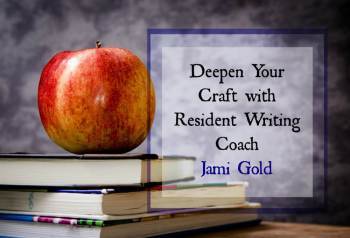Story Not Behaving? Try Going Deeper into Structure
RWC Coach Jami Gold

With all the writing advice out there, we know that some ���writing rules��� we hear are more like guidelines. However, story structure is important not just for our writing but also for our readers���creating their overall sense of our story���so we should consider the risks before ignoring structure-specific guidelines.
In fact, if our story isn���t working well, we might be able to fix the issue by going deeper into the reasons behind those guidelines. Let���s take one example of a relatively minor aspect of story structure (that most advice doesn���t even mention) and look at how it can affect our story���and how our story can ���break��� if we fail to include the details readers need.
Story Structure at the 25% MarkBefore we start, first know that different story structure systems use different names for each point, but the function they fulfill for our story is the same. In other words, the names don���t matter.
For example, most story structure systems include a plot event (a story ���beat���) around the 25% mark (often called the Catalyst, First Plot Point, or the End of the Beginning), and no matter the label used, the function of this beat is to create a ���point of no return��� forcing the protagonist into the story.

After this plot event, readers should have at least a hint of (and in many cases, a fairly good idea of):
the story goal(s) and reasons for the goal (stakes)the main conflicts/antagonists/obstacles blocking that goalsome of the internal issues complicating that goalThose all work together to tell readers who they���re rooting for or against, what they���re rooting for or against, and what our story is about.
If we fail to include a story beat with this function around the 25%-ish mark (usually between 20-30%), our story���s pace will likely feel slow and/or readers might close the book in frustration at not understanding the point of the story. A well-developed 25%-mark beat will establish the story, plot, conflicts, stakes, and character/emotional arcs of the story.
Internal Issues at the 25% MarkThose of you familiar with story structure probably expected those first 2 bullet points above, but maybe the last point was a surprise. Many story structure systems and beat sheets focus on the external issues of our story���plot, antagonists, villains, obstacles, etc.���and don���t touch on internal issues.
However, if we comprehend the deep, underlying purpose of a story���s structure at this 25% mark, we know that we want to not only show the goal our characters are aiming for, but also to at least hint at what���s preventing them from reaching that goal right now. After all, without something standing between our characters and their goal, readers will think our story would be over before it began. *grin*
For some stories, that ���something��� will be all about external obstacles and villains, just like the focus of most beat sheets. But for the remainder of stories (especially those with character arcs), readers should have seen hints by the 25% mark that the ���something��� also includes internal obstacles���such as characters��� false beliefs and backstory wounds���that interfere with the story goal(s) as well.
Going Deeper Helps Our Story (and Readers)What���s a reader���s experience if they don���t see (at least) hints of the internal obstacles that will be complicating the protagonist���s path toward the goal(s)?
Readers may think the external conflicts aren���t enough of an obstacle to the goal to create a story and simply close the book.Readers may question whether there���s anything other than a need for word count holding the character back from their goal (in a ���the character struggles because the plot needs them to��� problem) and lose patience with the story and characters.Negative character traits without a hint of an internal-arc goal to improve may be assumed to be permanent, which can make readers less likely to root for them.Any self-destructive (or obviously wrong) assumptions a character makes without a hint of how it ties into their internal arc (such as through a false belief or backstory wound) may make them less likable or sympathetic and lessen readers��� engagement with our story and characters.For example, let���s take a character who assumes no one likes them. If readers have seen evidence throughout the first act that the assumption isn���t true, they might have a negative impression of the character for making such a patently false assumption. The assumption could even make readers frustrated, contemptuous, and dull their emotional connection to our character���and story. Not good.

One potential fix? By the 25%-ish mark, give readers hints/glimpses/allusions to a backstory wound causing that assumption.
Even just a few words hinting at something (such as: He���d learned his lesson about trying to make friends years ago.) can make all the difference between a character that readers sympathize with and a character that readers disdain. The hints give a reason for the character���s internal issues that keeps readers in their corner���and rooting for them to improve.
Story Structure MattersJust as our story can look ���broken��� if we haven���t provided glimpses of enough conflict (external and/or internal) by the 25%-ish mark, similar problems can occur if we ignore the other major story structure guidelines or fail to go deep enough into the purpose behind each major story structure point. Story structure matters for creating the overall sense of our story���and for convincing readers that their time will be rewarded with a satisfying story.
So if we struggle with a story that seems broken, try going deeper into its structure and make sure to address the underlying purpose of each major beat in our story. We may discover a few easy edits to fix our story. *smile*
Do you have any questions or insights about story structure and how going deeper might help our story? Jami Gold
Jami GoldResident Writing Coach
After muttering writing advice in tongues, Jami decided to put her talent for making up stuff to good use. Fueled by chocolate, she creates writing resources and writes award-winning paranormal romance stories where normal need not apply. Just ask her family���and zombie cat. Find out more about Jami here, hang out with her on social media, or visit her website and Goodreads profile.
Twitter �� Facebook �� Pinterest
The post Story Not Behaving? Try Going Deeper into Structure appeared first on WRITERS HELPING WRITERS��.
Writers Helping Writers
- Angela Ackerman's profile
- 1014 followers



